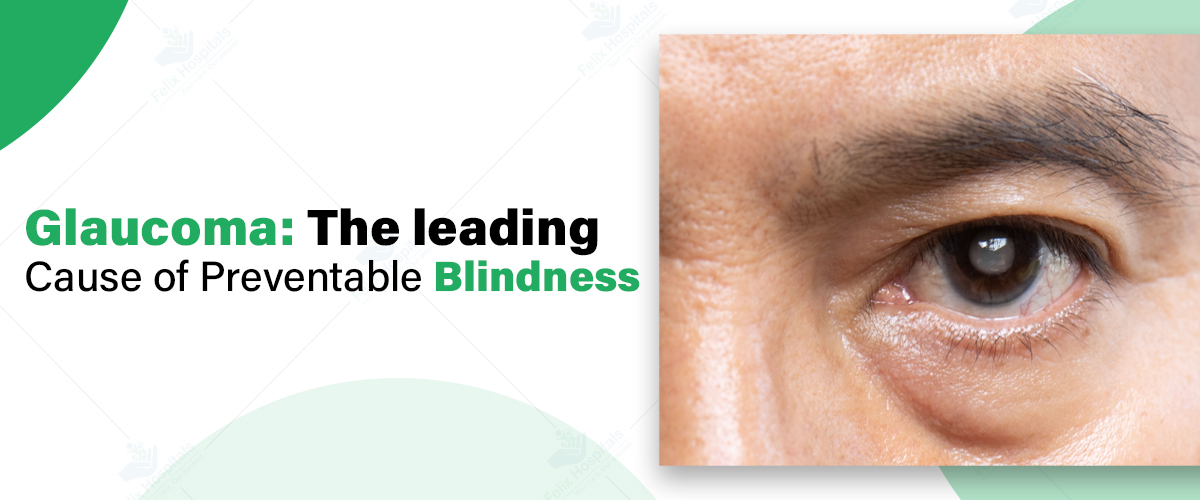
Subscribe to our

Glaucoma, often referred to as the "silent thief of sight," is a group of eye conditions that can cause irreversible damage to the optic nerve, leading to vision loss and, in severe cases, blindness. It is one of the leading causes of preventable blindness worldwide, affecting millions of people. Early detection and treatment are crucial to prevent significant vision loss. For those seeking the best ophthalmologist in Noida, expert care is essential in managing and treating Glaucoma effectively.
Don't wait for symptoms to worsen—Schedule your comprehensive eye exam today! Call Now - +91 9667064100.
Glaucoma is not a single disease but a collection of conditions that affect the optic nerve. The most common forms are:
Glaucoma is often asymptomatic in its early stages. However, as the disease progresses, symptoms may include:
While there is no cure for glaucoma, treatment can significantly slow or prevent further vision loss. Treatment options include:
Early detection is vital for preventing vision loss from glaucoma. Comprehensive eye exams are essential, including:
Several factors increase the risk of developing glaucoma:
There are several steps individuals can take to help prevent glaucoma and manage the condition effectively:
Living with glaucoma requires ongoing management and adaptation. Here are some strategies to help manage the condition and maintain quality of life:
Dr. Mohmad Uzair Zakai brings over a decade of expertise in ophthalmology, excelling in both fundamental and advanced eye procedures. With a focus on outpatient care and emergency management, he is skilled in conducting various ophthalmological investigations, including slit lamp examinations, OCT imaging, and fundus fluorescein angiography.
Dr. Deepanjali Arya is a distinguished ophthalmologist with more than 9 years of experience. She is dedicated to diagnosing, treating, and surgically addressing diverse eye conditions. Dr. Arya is committed to enhancing eye health through personalized treatment plans that cater to individual patient needs.
Reach out now to ensure your vision remains clear and healthy. Call +91 9667064100 to get started on safeguarding your sight!
Glaucoma remains a formidable threat to vision health, yet with early detection, proactive management, and adherence to treatment, individuals can mitigate its impact. By prioritizing regular eye examinations, understanding risk factors, and partnering with expert ophthalmologists at the best hospitals in Noida, individuals can take decisive steps towards protecting their vision and maintaining a fulfilling quality of life.
Glaucoma's impact on vision and quality of life underscores the importance of awareness and proactive eye care. With advancements in diagnosis and treatment, individuals with glaucoma can manage their condition effectively and continue to lead fulfilling lives.
1. Why do people get glaucoma?
Glaucoma typically develops when there is increased intraocular pressure (IOP) due to an imbalance between the production and drainage of fluid within the eye. This pressure can damage the optic nerve, leading to vision loss. Other risk factors include genetic predisposition, age, certain medical conditions (like diabetes), eye injuries, and prolonged use of corticosteroids.
2. What are the first signs that glaucoma is developing?
Glaucoma often develops gradually and without noticeable symptoms in its early stages. Early signs may include blurred vision, difficulty adjusting to darkness, and loss of peripheral vision. In more advanced cases, a person might notice a gradual narrowing of their field of vision or experience sudden loss of vision.
3. Can glaucoma be corrected?
While glaucoma cannot be cured, it can be managed and controlled with appropriate treatment. Early diagnosis and ongoing management can help prevent significant vision loss. Treatments may include medications (eye drops), laser therapy, or surgical procedures to lower intraocular pressure and prevent further damage.
4. Who suffers from glaucoma?
- Glaucoma can affect anyone, but certain groups are at higher risk, including individuals over the age of 60, those with a family history of the condition, people with high intraocular pressure, individuals with certain medical conditions (like diabetes or hypertension), and those of African, Hispanic, or Asian descent.
5. Is glaucoma painful?
Glaucoma itself is usually painless, especially in its early stages. However, acute glaucoma attacks (such as those caused by acute angle-closure glaucoma) can be very painful and may include symptoms like severe eye pain, headache, nausea, and vomiting.
6. Is glaucoma 100% curable?
Glaucoma is not 100% curable, but it is manageable with early detection and appropriate treatment. The goal of treatment is to control intraocular pressure and prevent further damage to the optic nerve, preserving vision.
7. Is glaucoma surgery painful?
Glaucoma surgery is generally performed under local anesthesia, so the procedure itself is not painful. However, patients may experience some discomfort and soreness during the recovery period. Pain is usually managed with prescribed medications and typically subsides as healing progresses.
8. What foods raise eye pressure?
Certain foods and dietary habits can potentially affect intraocular pressure. For instance, excessive salt and caffeine intake can increase eye pressure. It is also recommended to avoid high-sugar and high-fat diets, as they can contribute to overall health issues that may indirectly affect eye pressure. Maintaining a balanced diet rich in fruits, vegetables, and whole grains is beneficial for eye health.